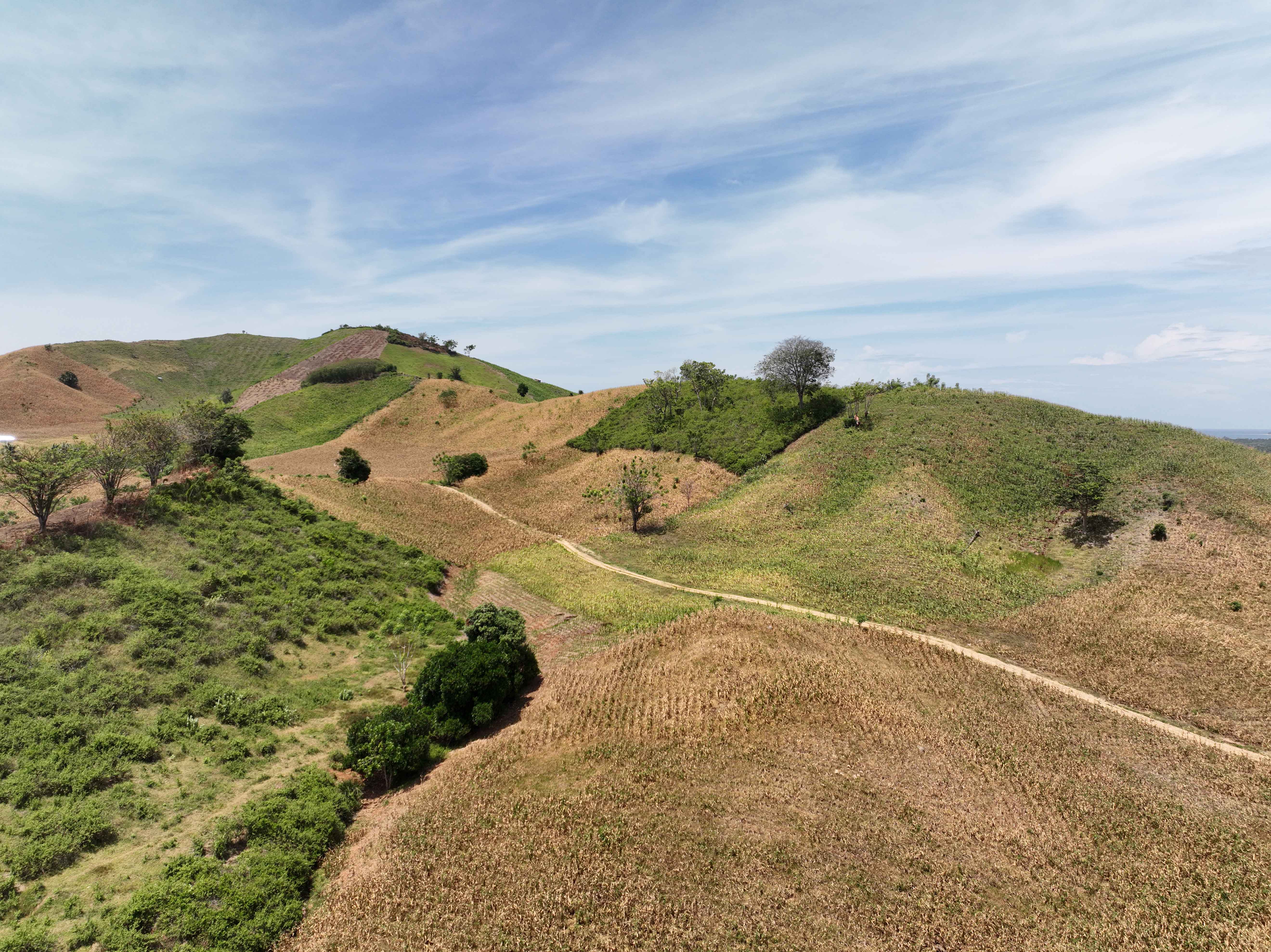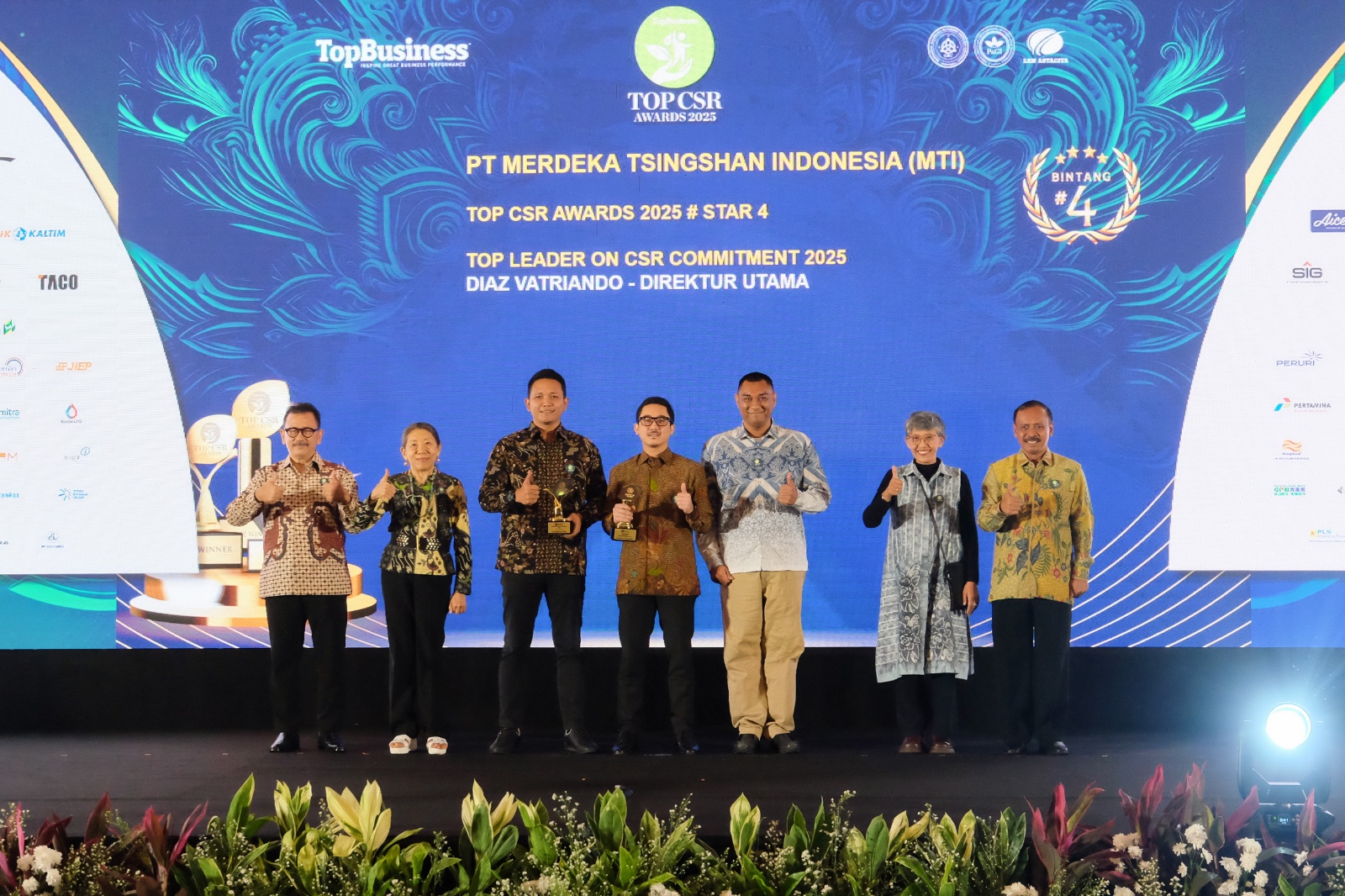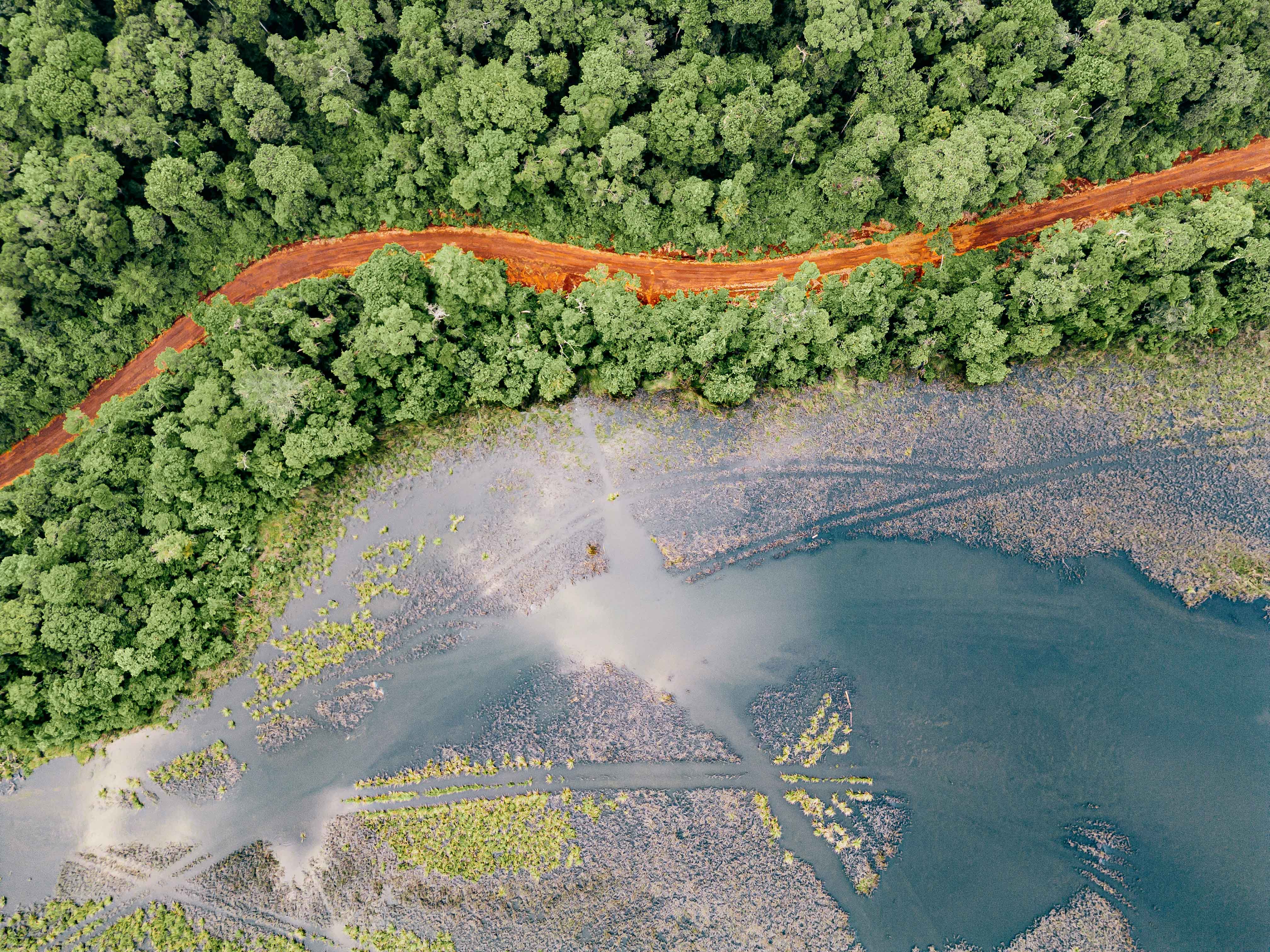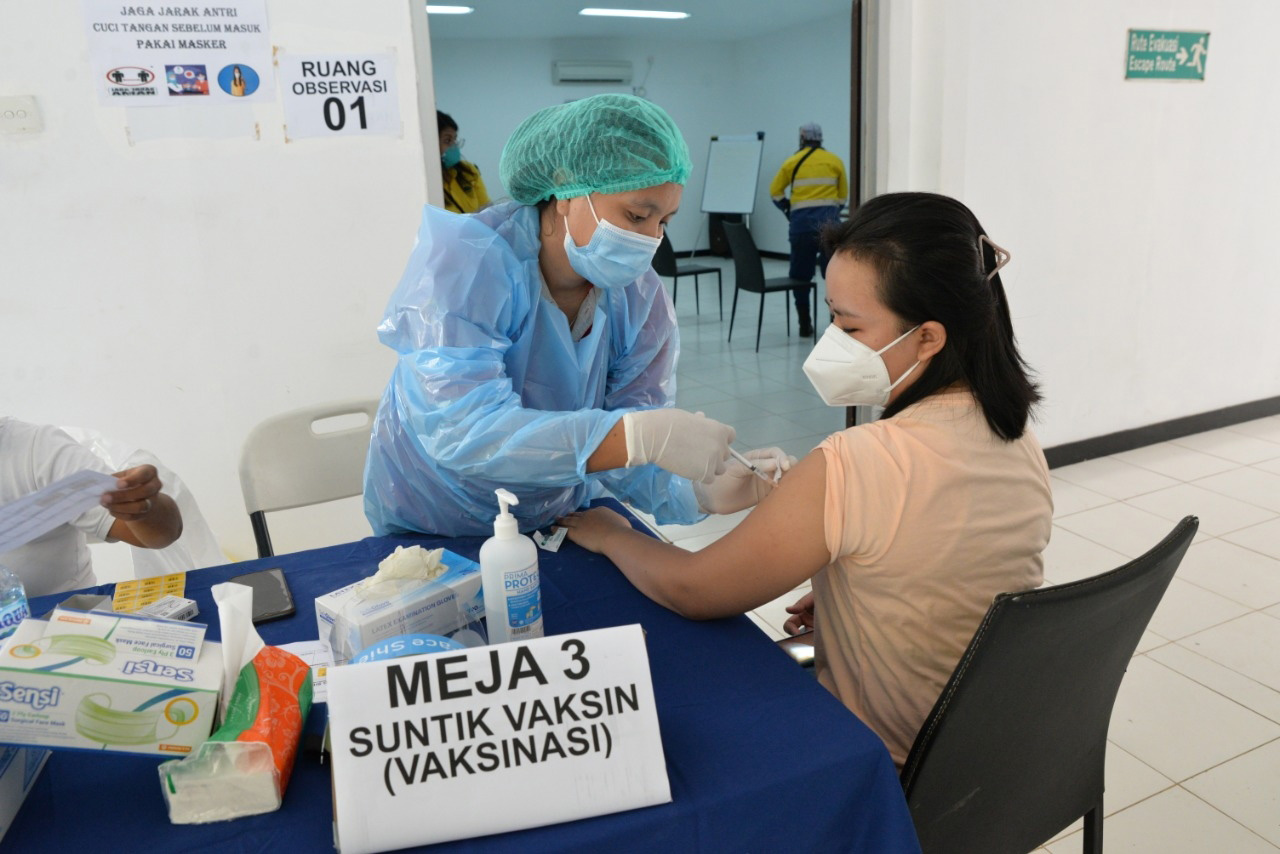
Strengthening the Foundation for Merdeka’s Future
The pandemic is not over, operational challenges are always present. For Merdeka, the only option is to keep moving forward.
Twelve large buses crawled out of the gates of Pos 6 site PT Bumi Suksesindo (BSI). The buses contained BSI employees and their family members. “Today, we are going to Krikilan Glenmore Hospital for vaccinations,” said dr. R. Istiko Mahendra, company doctor, in mid-June.
The group arrived at their destination an hour and a half later. They headed straight for the west side of the hospital. In a tent that was set up specifically for this vaccination activity, the hospital has prepared a registration table and staff. Even though there were hundreds of people coming, they didn’t crowd because the chairs were arranged more than a meter apart. They also have to wear masks. In this place, people are asked to submit their ID cards and fill out a registration form.
For those who did not get a seat, the officers asked them to stay away, filling out forms around the area. “Keep your distance, yes,” the hospital official said through the loudspeaker.
Inside the building, the officers were waiting. They are divided into four sections according to their respective tasks: the screening section, the injection section, the certificate printing section, and the drug section. People who have already filled out the form immediately move on to the screening site. Here, officers measure the blood pressure of vaccinated participants and ask about their medical history. If there are no problems, they can be injected with a vaccine and then receive a certificate and medicine. Everyone was given paracetamol after being vaccinated. At Krikilan, employees receive the AstraZeneca vaccine. After this first stage of injection, they will be injected again 12 weeks later.
According to dr. Istiko, BSI collaborated with several agencies to vaccinate employees, including Bhakti Husada Krikilan Hospital, Ar Rohmah Jajag Hospital, Fatimah Hospital Banyuwangi, and the Banyuwangi Kodim. Companies take advantage of unused vaccine quotas because their targets have contraindications, have died, don’t want to be vaccinated, or have moved to another city. “We are targeting 95 percent of employees to be vaccinated to achieve herd immunity,” he said.
Meanwhile, the Head of PT Bumi Suksesindo’s COVID-19 Task Force, Agus Purwanto, said that based on data as of July 28, 2021, 2,582 people had been vaccinated for the first phase, or 63 percent of the target of 4,099 people. In addition, 20 people have received the complete two-dose vaccine. The vaccine recipients consist of employees, contractors, and their families. “Most of them are still in the first stage of vaccination,” he said. Nevertheless, Agus is optimistic that the vaccination target will soon be achieved because the Gotong Royong vaccine has arrived.
The BSI Task Force hopes that this vaccination can contribute to accelerating the creation of group immunity, especially in Pesanggaran. “Because most of the employees and their families live in Pesanggaran,” said Agus.
Vaccination at BSI is a follow-up to the Merdeka group’s serious efforts to deal with COVID-19 for employees and their families. Apart from establishing a task force in each subsidiary, Merdeka also established a Vaccinee Committee Meeting consisting of representatives of the parent company and each subsidiary. This committee is tasked with pursuing vaccinations, one of which is by participating in the Mutual Cooperation Vaccine, a government vaccine program that is funded by business entities and legal entities independently. However, of the vaccines ordered for the needs of 6,668 people, Merdeka only received 2,000 doses of vaccine for a complete vaccination of 1,000 people. Therefore, the committee needs to distribute them carefully, adjusting to the conditions of each site.
In Pohuwato Regency, Gorontalo, the health facility appointed to handle the Peak Emas Tani Sejahtera (PETS) vaccination until the specified deadline in early July 2021 failed to obtain a P-Care application account from the Provincial Health Office. The BPJS Health application, which is used to record the recipients of the COVID-19 vaccine, is one of the conditions for the delivery of the Gotong Royong vaccine by Biofarma, which imports and distributes vaccines. Fortunately, vaccinations by the Gorontalo local government are already running. The Merdeka vaccine committee then directed 40 PETS employees to access the vaccination. However, hastening the vaccination is much better than waiting. Vaccines that cannot be delivered to PETS are transferred to other subsidiaries.
Banyuwangi’s situation is different. The local government vaccination program is already running. Even several hospitals in Banyuwangi still have quite a lot of vaccines that are unused and nearing their expiration date. The vaccine quota was then used by BSI. Considering these conditions, the Merdeka vaccine committee decided to send more vaccines to Batutua Kharisma Permai and Batutua Tembaga Raya (BKP-BTR) on Wetar Island, Southwest Maluku. The location is in remote Indonesia.
On July 4, 2021, Biofarma sent 2,000 doses of vaccines ordered by Merdeka to three locations of health care facilities that collaborate with Merdeka. A total of 176 doses of vaccine can be used for 88 BSI employees to Banyuwangi; 1,600 doses of vaccine (800 employees) for BKP-BTR in Wetar, and 224 doses of vaccine (112 employees) for Merdeka headquarters in Jakarta. The Gotong Royong vaccination is prioritized for employees whose work demands more intense interaction with many parties.
At the Merdeka headquarters, the first dose of Gotong Royong vaccination will be carried out starting July 8, 2021. Apart from relying on the Gotong Royong vaccine, employees of the Merdeka headquarters also access vaccines from various DKI Jakarta government programs. On July 28, 2021, 199 of the 242 employees of the Merdeka head office were recorded to have been vaccinated, either through the Gotong Royong vaccination or other routes. The next day, Merdeka headquarters employees began receiving the second dose of Gotong Royong vaccination.
Meanwhile, BKP-BTR has carried out the first dose of vaccination for a week since 16 July 2021 to all employees and contractors. The vaccination was carried out by the BKP-BTR Clinic paramedic team, in collaboration with Siloam Kupang Hospital and Lurang Health Center. According to Hotmonang F. Sitanggang, Senior Manager Commercial & Human Resources BKP-BTR, and dr. Agus Juanda at the BKP-BTR Clinic, on July 29, 2021, all the Gotong Royong vaccines from Merdeka for 800 people have been used—even not enough because the total vaccine recipients at BKP-BTR are 1,548 people, consisting of employees and contractors at the site. The second dose of vaccination will be carried out on August 6, 2021. Currently, BKP-BTR has also received an additional 42 doses of vaccine that are not used at Merdeka’s headquarters in Jakarta.
In Pohuwato, 37 of the total 44 PETS employees as of 26 July 2021 have been vaccinated through the local government’s vaccination program. Ten of them had received a complete two-dose vaccination. While 27 others have received the first dose of the vaccine. There are only 7 employees who have not received the vaccine. Two of them are COVID-19 survivors who must wait at least three months after testing negative to be vaccinated, one person has comorbidities or comorbidities that need further diagnosis to be vaccinated. The rest are waiting for vaccination in their respective domicile areas.
Merdeka continues to strive to procure vaccines for each of its employees, monitor the vaccination process in each of its subsidiaries, and educate the importance of vaccination to all relevant stakeholders. Vaccination is very important. After all, it will benefit employees, as well as the company because it can maintain the continuity of its operations. In addition, the company environment also benefits because more people have been vaccinated.
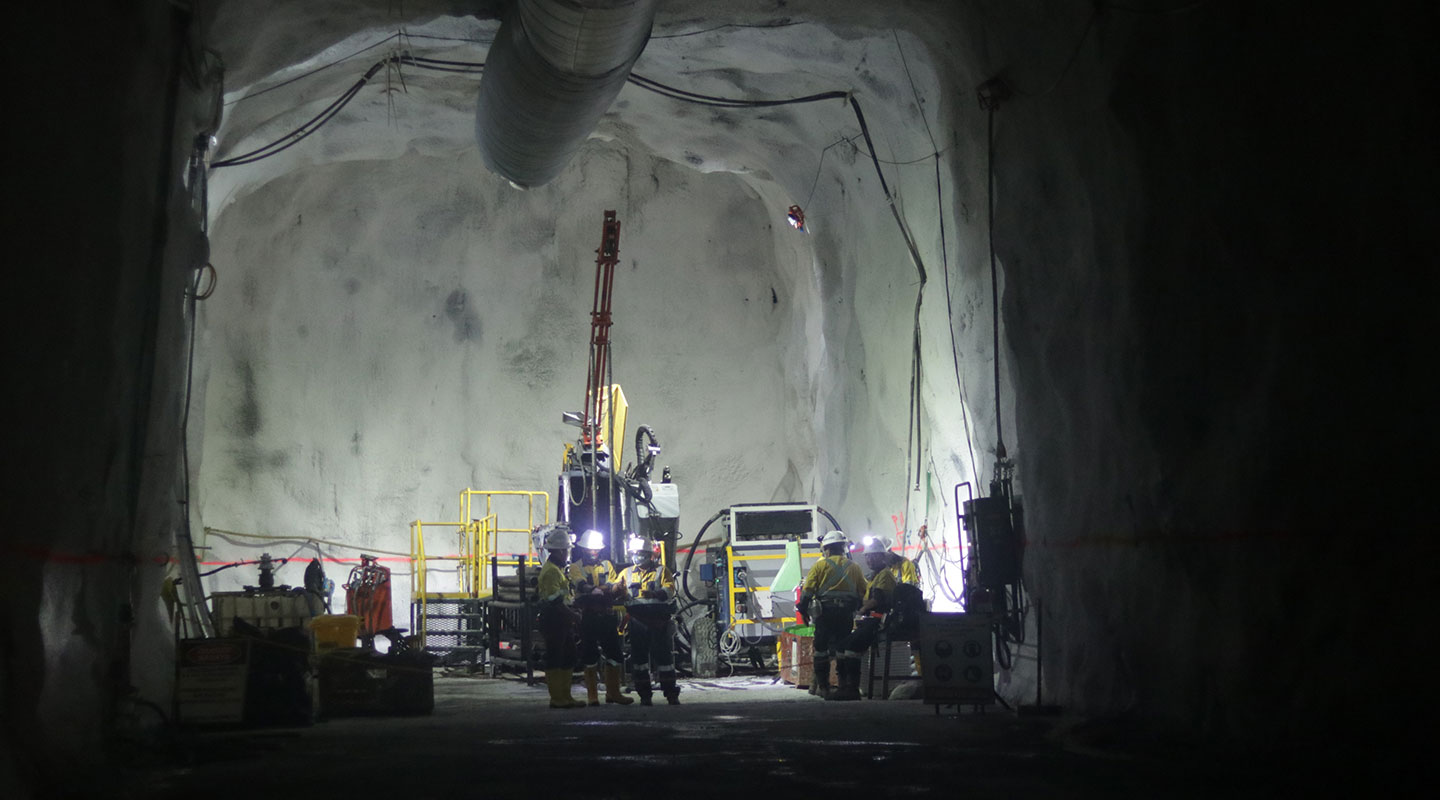
The construction of the buttress took place in the Pad A and Pad B areas. According to the Head of the HLO (Heap Leach Operation) Department, Hariadhi Anjar Kusuma, the buttress serves to strengthen the stability of the slopes when the ore is piled up again in that place. In addition, the construction team also installed a piezometer: a geotechnical instrument for measuring water content. With this tool, it is hoped that the occurrence of falling events can be mitigated earlier. Currently, there are still 6 of the 16 tools that will be installed. “Improvements in the heap leach are carried out in several phases by prioritizing operational needs so that the production process continues to run smoothly,” said Anjar.
In addition to repairs on Pad A and Pad B, the company is also accelerating the construction of new leachate reservoirs, namely PLS (pregnant leach solution) and ILS (intermediate leach solution). In general, the repair activities have been running by the production plan that has been targeted by the company. The biggest challenge is when the rainy season arrives, while the PLS and ILS pools have not yet been completed. Under such circumstances, the gold recovery process will be hampered because it is deluded by rainwater in the leach pad area. In conditions like this, more effort is needed to ensure production continues to run according to target.
In addition, the company is also in the process of obtaining a leach pad expansion permit (Pad C). “The total improvement of the leach pad has reached 63 percent,” said Anjar.
Meanwhile, the underground project is still at the pre-feasibility study stage. Workers are still taking samples for analysis. Drilling is carried out at various depths up to a maximum depth of 1,000 meters. It is hoped that this activity will confirm the mineral content, particularly gold and copper, underground. “If it is calculated until the start of production, underground projects are still 20 percent,” said Porphyry Study Project Geologist BSI, M. Hafid Rahadi.
Hafid continued, that the condition of the soft rock beneath the ground is the main obstacle that hinders the pace of project development. “So far it’s still on the track,” he said. However, there is a possibility that the project development timeframe could be longer than planned because the target is based on the project where the rock is harder while the rock in Tumpang Pitu is very soft.
The current length of the tunnel has reached 1,800 meters. Tunnel construction activities have been stopped since mid-2020. As planned, the addition of tunnel depth will be continued again next year on the condition that the data required at the current depth is sufficient.
The story from the Tujuh Bukit site in Banyuwangi is one of the many operational challenges that Merdeka Copper Gold has faced this year. And, Merdeka chose to keep moving forward. At the end of the first quarter of 2021, the good news came one of which was through a change in the composition of Merdeka’s board of directors which gave rise to a new leader.
At the Merdeka General Meeting of Shareholders on May 25, 2021, in Jakarta, Merdeka appointed Albert Saputro as the new President Director, replacing Tri Buwono who resigned. At a very young age, 35 years old, Albert was trusted to take Merdeka to a higher level. Albert himself is not new to the Merdeka environment. In the last five years, he has co-managed Merdeka’s investments through PT Saratoga Investama Sedaya Tbk, one of Merdeka’s largest shareholders. “It’s time for me to jump right in,” said Albert. He wants to play a role as a bridge for many parties and is very optimistic about Merdeka.
Another good news from Merdeka is that its performance is increasing. In the first quarter of 2021, Merdeka managed to generate revenue of US$ 46.55 million, which was largely due to increased gold and copper production by Merdeka’s subsidiaries.
Gold production in the first quarter of 2021 managed to reach 16,585 ounces, a significant increase compared to 5,355 ounces—the total production in the fourth quarter of 2020. In April, the first month of the second quarter of 2021, the accumulation of new ore in the Pad B area of BSI caused gold production for that month to decline, from about 5,000 ounces in the previous month to about 4,000 ounces. However, after the ore stacking process was completed, monthly gold production immediately increased dramatically, bringing total gold production in the second quarter of 2021 to 37,779 ounces—more than double the gold production in the first quarter of 2021.
Meanwhile, copper production in the first quarter of 2021 managed to reach 2,489 tons, more than double the production in the fourth quarter of 2020, which was 1,017 tons. Copper production in the second quarter of 2021 continues to grow every month. Total copper production in the second quarter of 2021 reached 5,003 tons—more than double the production in the first quarter of 2021. This significant gradual increase is certainly good news for Merdeka.
Starting in the third quarter of 2021, Merdeka will continue to increase its gold and copper production, to achieve the total 2021 gold production target, which is between 100,000–120,000 ounces of gold and 14,000–17,000 tons of copper. That way, by the end of 2021, Merdeka is optimistic to increase its income, more than the previous year.
Apart from handling operational issues, Merdeka continues to develop projects that will improve the company’s performance to achieve its vision to become a leading mining company in Indonesia.
As a subsidiary of Merdeka, BSI is still collecting data to prepare a pre-feasibility study for underground copper mines or what is commonly known as an underground project. The ore potential under pit A Tujuh Bukit is no joke, it can reach 1.9 billion tons, consisting of 8.7 million ounces of copper and 28.3 million ounces of gold. The world-class ore content can be compared to Bukit Hijau copper in Sumbawa and Grasberg in Timika.
The exploration process, which began with infrastructure development and drilling completed in June 2020, was carried out to investigate the amount, shape, and grade of ore content—how high the copper content is, what associated minerals are, and to what extent these associated minerals add to its economic value. and no less important, how to transport it. The more data generated, the more basis for planning the most appropriate mining method, including measuring infrastructure requirements. Recording of the existing condition of the coastal environment is also carried out which will be the basis for future environmental monitoring activities.
BSI’s attention also falls on the process of separating copper, gold, and other minerals from mined ores. Because the underground rock structure is different from the oxide rock on the surface, it is estimated that the mineral extraction method of this underground mine will be different from the heap leach method currently being carried out at the Tujuh Bukit open pit.
The plan is that ore processing will be carried out through the process of crushing, grinding, flotation, and drying. This process aims to separate copper, gold, and other valuable minerals from the ore. The remainder of this separation process is called tailings, the material is in the form of fine sand left over from ore processing. Typically, tailings are stored in a special dam or Tailings Storage Facility (TSF). The tailings that have been deposited in the solid material settling pond in the dam will be processed first at the waste management installation, before finally when they are safe from hazardous chemicals, flowed into the river. Another method of tailings placement is Deep Sea Tailings Placement (DSTP), which is the placement of tailings in the deep sea using pipes. Gravity and deep-sea currents will keep the tailings on the deep-sea floor. Deep-sea water has a low dissolved oxygen level, which inhibits the possibility of tailings chemical reactions occurring.
Currently, BSI is considering which tailings placement method is the most appropriate and environmentally safe. The results of the pre-feasibility study are planned to be completed by the end of 2021, and to be submitted to the government for an operating permit.
In Morowali, Central Sulawesi, Merdeka will begin the development of an existing operation, marked by the completion of a feasibility study for the Acid, Iron, Metal (AIM) Project. This project is a further innovation from the Batutua Kharisma Permai and Batutua Tembaga Raya copper mining and processing companies (BKP-BTR).
As in the Tujuh Bukit operation, BKP as a copper mining company also applies an open-pit mine. BKP also uses the heap leach method to extract copper content. It is the extracted copper that has been transferred to BTR to be processed into copper plates.
However, upon closer inspection, it turns out that not all mineral content can be extracted from the leachate. The fine rock or ore that is piled up in the leachate still contains residual minerals of economic value, one of which is pyrite—the raw material for batteries. This opens a new opportunity to extract the remaining ore piles in the leachate which will become a new source of income for Merdeka.
To that end, Merdeka cooperated with Eternal Tsingshan Group Limited and established PT Merdeka Tsingshan Indonesia (MTI) which will run and operate the AIM Project, with a composition of 80 percent owned by Merdeka and 20 percent by Tsingshan.
MTI will be established in an industrial complex in Morowali, consisting of various factories that will be the consumers of most of the mineral content extracted by MTI. That way, the presence of MTI will add to the production chain in Wetar. BKP mines and produces copper extract, while the results are then processed into copper plates by BTR. Meanwhile, the remaining ore from leaching at BKP will be transported by MTI to be processed and the product sold to factories that are still in the same complex as MTI.
Currently, Merdeka is in the process of obtaining permits for the establishment of the MTI factory, as well as establishing a special port to transport ore from the BTR leachate to MTI. It is planned that the construction of the MTI plant will begin in the second quarter of 2021. MTI is targeted to start production in the fourth quarter of 2022.
“Freedom’s investment in the AIM project is approximately USD 300 million over two years, with USD 100 million to be executed in 2021. AIM’s products to be commercialized are sulfuric acid and steam with expected revenue of USD 170 million per year for more than 20 years, “said Albert Saputro, President Director of Merdeka.
Meanwhile, the negotiations between Merdeka and J Resource regarding the gold mining plan in Pani are still ongoing. If running smoothly, the Pani Project is projected to produce more than 250,000 ounces of gold per year for 15 years.
Albert Saputro believes that the Merdeka Group will undergo an important transition in the next ten years to become a larger company to support new developments in operations and projects in the future, with a longer operating life. He also imagines that Merdeka can always be an option for anyone who wants to cooperate in mineral mining projects. “I want us to be partners of choice.”
In the last two years, the Merdeka Group has never been free from challenges. However, with the immediate completion of the repair of the leachate platform and the construction of a new leachate reservoir at BSI, the potential for production of the BSI underground project, and the commencement of construction of the AIM project in Morowali, Albert is optimistic about the future of Merdeka. According to Albert, the key to that vision is to continue to be professional and everyone must be held accountable. “Both are a reflection of respect,” said Albert.
